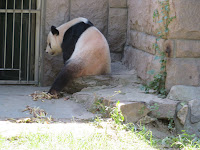China tour – 2
On the evening of 4th
Sep. we left Xian for Beijing by a local flight. In the flight we did not get anything to eat
as they have not been advised of special meals, vegetarian, for us. But the airlines staff had been kind enough
to pass on yoghurt and fruit from their rations. This suited us also as we had packed ready
food which we could take in the hotel at Beijing along with this yoghurt and
fruit, as dinner.
 Walking along the square we
proceeded to the Forbidden City, as the Chinese imperial palace from the Ming
dynasty to Qing dynasty i.e. from 1420 to 1912, is called. It is located in the centre of Beijing and now
houses the Palace Museum. The complex
consists of 980 buildings and covers over 180 acres and is now a World Heritage
Site. During the cultural revolution in the 1960s, Premier Chou en Lai took
special efforts to guard the City from being destroyed by the the Red Guards. We later visited the Temple of Heaven, the temple where
the emperors of the Ming and Qing dynasty would worship the God and pray for
good harvest. We also watched this day a
Chinese musical play “The Golden Mask Dynasty” which was excellent. The play
featured brilliant Chinese dances, acrobatics, costumes, lighting and acoustics
and included more than 200 actors.
Walking along the square we
proceeded to the Forbidden City, as the Chinese imperial palace from the Ming
dynasty to Qing dynasty i.e. from 1420 to 1912, is called. It is located in the centre of Beijing and now
houses the Palace Museum. The complex
consists of 980 buildings and covers over 180 acres and is now a World Heritage
Site. During the cultural revolution in the 1960s, Premier Chou en Lai took
special efforts to guard the City from being destroyed by the the Red Guards. We later visited the Temple of Heaven, the temple where
the emperors of the Ming and Qing dynasty would worship the God and pray for
good harvest. We also watched this day a
Chinese musical play “The Golden Mask Dynasty” which was excellent. The play
featured brilliant Chinese dances, acrobatics, costumes, lighting and acoustics
and included more than 200 actors. 
The
next morning we visited the famous Great wall of China, which is a World Heritage
Site. The Great Wall of China
is the world's longest
wall and biggest ancient architecture. The Great Wall is more
than 2,300 years old and
more than 13000 miles long. It
was built mainly during the three dynasties – Qin Dynasty, Han Dynasty and Ming
Dynasty. The Great Wall is not a continuous line; there are side walls, circular walls, parallel walls and sections with natural
barriers like high mountains. We went to
Juyong pass section of the Great Wall, also known as Juyongguan Great Wall,
which is the closest section of the Great wall to Beijing. The rugged mountain scenery is beautiful and
the fort and perimeter wall has been renovated and well maintained. We did not climb to the fort at the top and
returned midway. Only a few in the tour
group ventured to climb to the top. On our way back we stopped at a Jade
exhibition and a traditional enamelware factory, known as Cloisonne factory.
After the Hutong Life tour we retired to the hotel for
the final night of stay in Beijing. We
stayed here three nights in the hotel, Ramada Beijing North. The hotel was not to our liking as it was not
centrally located and there was no mall or convenience store located near it.
The national guide, Leo, who received us at the Beijing airport and stayed with
us till the end of tour, helped us by getting us a box of yoghurt containing 8 cartons, which we
made use with the ready food we brought from Sydney as dinner in two nights of stay here. Photos
taken in Beijing can be seen in the Flickr album “ Beijing, China” @ https://www.flickr.com/photos/sam-sekar/albums/72157698374525032
-------------------------------------------------





Dear Sam, Have read your blog and seen all the fotos. Very interesting. Only prob seems to have been food. Otherwise, you definitely had a memorable experience. Regards::PattabiRaman::
ReplyDelete